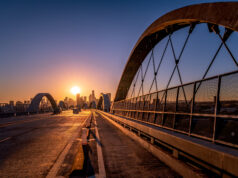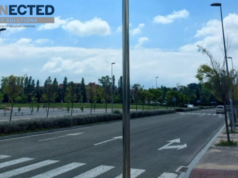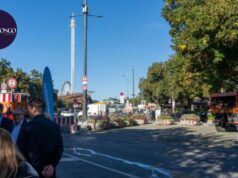Lighting specialist Bryan King reviews the increasingly controversial debate about the colour of public lighting in New Zealand.
There is no hotter topic in New Zealand public lighting today than the debate over what is the most appropriate Correlated Colour Temperature (CCT) for public space lighting.
- Amber light at 2000 Kelvin?
- Warm white light at 3000 Kelvin?
- Neutral white light at 4000 Kelvin?
LED lighting is now ubiquitous in new and refurbished public lighting applications with the technology advancing to the point that the CCT possibilities are wide open. However, councils and road authorities are faced with a challenging dilemma. In the face of increasingly vocal advocacy by special interest groups, what is the right choice of colour temperature?
It is difficult to find well-researched and balanced discussion on the issues to guide decisionmakers in councils, road authorities, consultancies, or government. In recent times the public lighting scene has been awash with media and internet commentary about the characteristics of LED outdoor lighting, much of it from health, astronomical and ecological commentators focusing on their views of the shortcomings of the technology. Whilst well intended, much of the commentary advocates single-issue perspectives that do not include lighting science and expert application input and only considers a narrow range of light spectrum and CCT issues.
A broader view is needed. When assessing the suitability of outdoor lighting it is necessary to engage with the overarching issues of public safety, application practicalities, technical standards, local government regulation, and of course budget constraints. In New Zealand, there is a growing and valid market demand for public lighting owners, managers, and designers to consider and act on improvements for human, astronomical and ecological issues, but these topics have to be balanced with numerous practical and financial considerations.
LEDs are not just much more efficient and more reliable. Compared to legacy luminaires, well-configured LEDs in well-designed lighting schemes do a much better job of sending light to where it is intended and not elsewhere. As the LED technology wave approaches its maturity, digital lighting controls are the second-wave of this step-change innovation. Digital control opens up more avenues for energy and operational cost savings, as well as meeting the growing market demand for measurable low-carbon infrastructure and more environmentally astute solutions. A third wave beckons in the form of colour tuneable programmable CCT luminaires with the ability to deliver amber/warm/cool selectable CCT’s as desired over each night-time cycle.
To illustrate the challenge, consider the 2000K amber luminaires favoured by many astronomers and ecologists. These are more expensive than the more common 3000K or 4000K versions, they are not as energy efficient, and AS/NZS 1158 lighting design standards require designers to de-rate the light output of low CCT light sources as their performance in delivering visual acuity for humans is not as good as that of 3000K or 4000K luminaires. In short, you need much more 2000K light to achieve the same visual and safety outcomes as 3000K or 4000K luminaires. Raising lighting inputs in this way to meet safety objectives may actually increase overall light pollution, and hence defeat the original objective.

Colour temperature of lightsources – From warm to cool
Lighting Council New Zealand (LCNZ) has developed a night sky Position Statement in conjunction with the professional body for lighting designers and engineers, the Illuminating Engineering Society of ANZ (IESANZ). See ‘Good Lighting and Dark Skies – a Pathway for Progress’. Weblink Here. This statement highlights that night sky protection is a high priority for responsible designers and suppliers, and outlines strategies and methods for achieving better outcomes in NZ, including colour temperature application advice.
There is currently a NZ Parliamentary Petition in process on light pollution. See ‘New Zealand needs a national law to limit light pollution and promote dark skies’. Weblink Here.
This petition is by astronomical experts advocating for the introduction of national outdoor lighting legislation across NZ, including specific limits for lower CCTs for outdoor light sources. It is good that this petition is heightening general awareness of the implications of light colour issues. Whilst the desired outcomes are commendable, the legislative mechanism proposed is heavy-handed and duplicative, and the petitioners’ astronomical interests do not appear to be sufficiently inclusive of the interests and outcomes of other stakeholder groups.
NZ has well-developed lighting technical standards (AS/NZS 4282 Control of the obtrusive effects of outdoor lighting, and the series AS/NZS 1158 Road and public lighting) that define good design for outdoor lighting, with recommended CCT values, and most local councils already have planning codes and bylaws for outdoor light, spill light and obtrusive light. However, these local government regulatory measures are somewhat patchy across NZ in both execution and implementation, and there is considerable opportunity for national co-ordination to refine and harmonise existing bylaws to enable more effective and economic application at regional and local levels. The provision of quality and fit-for-purpose outdoor public lighting with due consideration of relevant environmental aspects is a basic responsibility of owners and managers of lighting assets, with technical assistance from their lighting designers.
How can progress best be made? One leap forward was clearly visible with the staging of the inaugural 2022 Responsible Outdoor Lighting at Night (ROLAN) international web-conference, organised by the Chartered Institute of Building Services Engineers (CIBSE) UK. Weblink Here.
This event brought together a diverse range of previously siloed NGO groups representing both demand-side and supply-side outdoor lighting interest parties. The expert presenters from the fields of lighting physics, lighting design, environmental science, biology, astronomy, medical science, and legal aspects demonstrated a healthy exchange of concerns, ideas and suggestions, and these appear to be now moving steadily towards consensus views that have the makings of practical progress at a global level.
We need a similar cross-party forum for New Zealand and Australia, to break the barriers to effective communication …. Who is up for it?
Bryan King is a New Zealand lighting consultant active in lighting energy, environmental and urban light planning. In addition to NZS and AS/NZS standards he represents NZ in ISO and IEC (Geneva) standardisation for lighting product and application safety, performance and environment. Bryan is Executive Director of Lighting Council New Zealand, the industry association for lighting product manufacturing, importing, and distribution companies in New Zealand.















